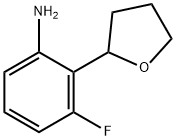
3-fluoro-2-(tetrahydrofuran-2-yl)aniline synthesis
- Product Name:3-fluoro-2-(tetrahydrofuran-2-yl)aniline
- CAS Number:1384984-24-0
- Molecular formula:C10H12FNO
- Molecular Weight:181.21

1191-99-7
343 suppliers
$10.00/10g

59255-94-6
145 suppliers
$19.00/1g

1384984-24-0
2 suppliers
inquiry
Yield:1384984-24-0 84%
Reaction Conditions:
Stage #1: 2,3-dihydro-2H-furan;2-bromo-3-fluoronitrobenzenewith di-μ-bromobis(tri-tert-butylphosphino)dipalladium(I);N-ethyl-N,N-diisopropylamine in 1,4-dioxane; for 2 h;Reflux;
Stage #2: with 5%-palladium/activated carbon;hydrogen;triethylamine in methanol at 20; under 2327.23 Torr;Inert atmosphere;
Steps:
2 Preparation of 3 -fluoro-2-tetrahydrofuran-2-yl-aniline(16)
Placed 5% palladium on carbon (37.3 g, 50% wet, 8.76 mmol, Aldrich 330116) in a Parr bottle under nitrogen, followed by MeOH (70 mL, JT-Baker909333). Added the crude mixture of 2-(2-fluoro-6-nitro-phcnyl)-2,3 -dihydrofuranand 2-(2-fluoro-6-nitro-phenyl)-2,5-dihydrofuran (15A&15B) (186.6 g, 892.1 mmol) dissolved in MeOH (117 mL), followed by NEt3 (124.3 mL, 892.1 mmol, Sigma- Aldrich 471283). Placed the vessel on a Parr shaker and saturated with H2. After adding 45 psi H2, the reaction mixture was shaken until consumption of the startingmaterial was complete (HPLC and LCMS showed complete reaction). The reaction mixture was purged with nitrogen, filtered through CeliteTM and rinsed with EtOAc. The filtrate was concentrated on a rotary evaporator giving a brown oil, which was dissolved in Et20 and washed with water (2x). The ether phase was extracted with aqueous 1 N HC1 (5 x 250 mL), which was washed with Et20 (3x) and then basifiedwith aqueous 6 N NaOH to pH 12-14. The basic aqueous phase was extracted with CH2C12(4x), and the combined organic extract washed with saturated aqueous NH4C1, dried over MgSO4, and filtered through a pad of silica eluting with CH2C12 to 25% EtOAc / hexane. The desired filtrate was concentrated under reduced pressure giving 16 as a light brown oil (121.8 g, 84% GCMS plus NMR purity). GCMS (Agilent HP-5MS 30 mx 250 jim x 0.25 jim column heating at 60°C for 2 mm to 300°C over 15mm with a I mL/min flow rate) M+1: 182.0 (11.44 mm). LCMS (Cl 8 column elutingwith 10-90% CH3CN / water gradient over 5 minutes with formic acid modifier) M+1:182.10 (2.61 mm). ‘H NMR (300 MHz, CDC13) ? 6.97 (td, J = 8.1, 6.3 Hz, 1H), 6.436.35 (m, 2H), 5.21 -5.13 (m, 1H), 4.54 (s, 2H), 4.16 -4.07 (m, 1H), 3.90 - 3.81 (m,1H), 2.23 - 2.00 (m, 4H) ppm. Additional crops were obtained as follows: the combined ether phase was washed with saturated aqueous NaHCO3, brine, dried over Na2SO4, decanted, and concentrated under reduced pressure. The oil was vacuum distilled (ca. 15 torr) collecting the distillate at 101 - 108°C. To a stirring solution of the distilled oil in EtOH (1 volume) at 2°C was slowly added 5 M HC1 (1 eq) in iPrOH.The resulting suspension was brought to room temperature, diluted with EtOAc (3 volumes, vol/vol), and stirred for 2 hrs. The white solid was collected by filtration, washed with EtOAc, and dried under reduced pressure giving a second crop of product as the HC1 salt. The mother liquor was concentrated to a slurry, diluted with EtOAc and the solid collected by filtration, washed with EtOAc, and dried in vacuo giving the HC1 salt as a third crop of the product. LCMS (C18 column eluting with 10-90%CH3CN / water gradient over 5 minutes with fonnic acid modifier) M+1: 182.10 (2.58mi. 1H NMR (300 MHz, CDC13) 10.73 (br.s, 3H), 7.66 (d, J = 8.1 Hz, 1H), 7.33(td, J = 8.2, 5.9 Hz, 1H), 7.13 -7.05 (m, 1H), 5.26 (dd, J = 9.0, 6.5 Hz, 1H), 4.38 -4.28 (m, 1H), 4.00 - 3.91 (m, 1H), 2.59 - 2.46 (m, 1H), 2.30 - 1.95 (m, 3H) ppm. The overall yield from the three crops was 76%.
References:
WO2014/15105,2014,A1 Location in patent:Paragraph 00167; 00168; 00169

59255-94-6
145 suppliers
$19.00/1g

1384984-24-0
2 suppliers
inquiry